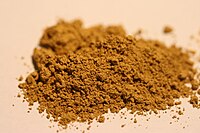
Photo from wikipedia
Most of the magnificent wall paintings from the ancient city of Pompeii are decorated with red and yellow colors coming from the ochre pigments used. The thermal impact of the… Click to show full abstract
Most of the magnificent wall paintings from the ancient city of Pompeii are decorated with red and yellow colors coming from the ochre pigments used. The thermal impact of the pyroclastic flow from the eruption of Vesuvius, in AD 79, promoted the transformation of some yellow painted areas to red. In this work, original red ochre, original yellow ochre, and transformed yellow ochre (nowadays showing a red color) of wall paintings from Pompeian houses (House of Marcus Lucretius and House of Gilded Cupids) were analyzed by means of a handheld energy-dispersive X-ray fluorescence spectrometer to develop a fast method that allows chemical differentiation of the original red ochre and the transformed yellow ochre. Principal component analysis of the multivariate obtained data showed that arsenic is the tracer element to distinguish between both red colored ochres. Moreover, Pompeian raw red and yellow ochre pigments recovered from the burial were analyzed in the laboratory with use of a benchtop energy-dispersive X-ray fluorescence spectrometer to confirm the elemental composition and the conclusions drawn from the in situ analysis according to the yellow ochre pigment transformation in real Pompeian wall paintings.
Journal Title: Analytical and Bioanalytical Chemistry
Year Published: 2017
Link to full text (if available)
Share on Social Media: Sign Up to like & get
recommendations!